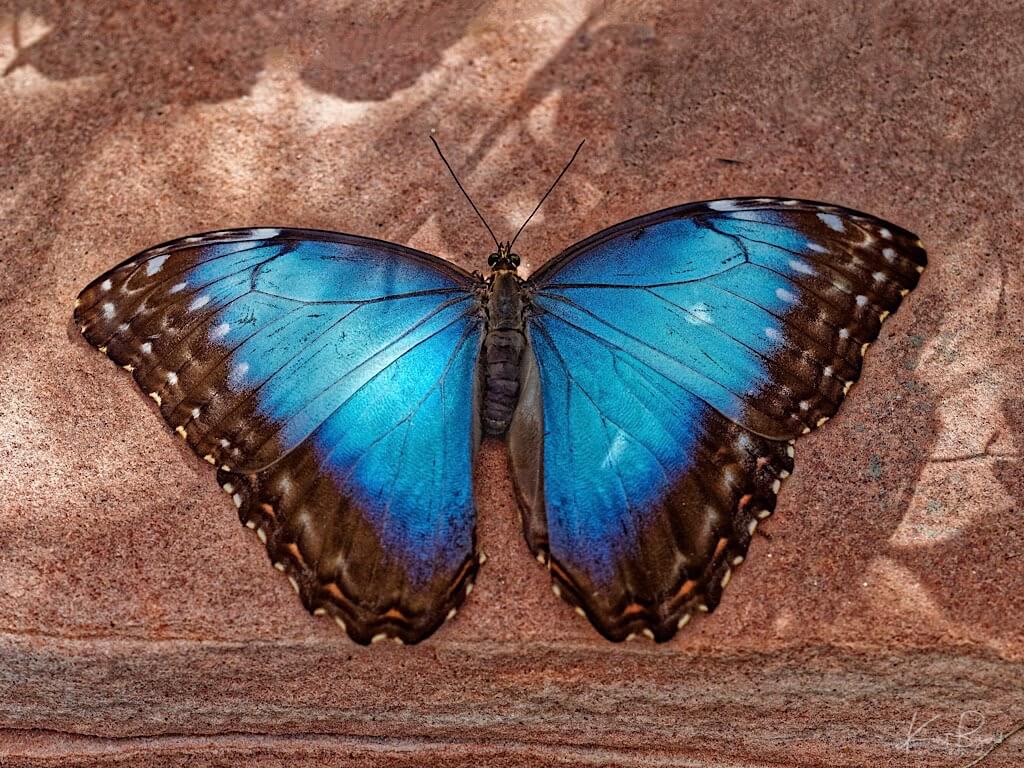
Butterflies have been held in reverence and high esteem for millennia, enshrined by the ancient Greeks in the mythical love affair between Cupid/Eros and Psyche the butterfly goddess. According to Greek mythology, Psyche was a beautiful maiden who fell in love with Eros/Cupid. Cupid’s mother, Aphrodite, was jealous of Psyche’s beauty and tried to keep the lovers apart. Eventually, however, Aphrodite realized that Cupid and Psyche were destined to be together and so Zeus made Psyche immortal. Psyche is also the Greek word for “soul” and “butterfly.” Although the original Greek story has been lost to history, the mythology of Cupid and Psyche was preserved in the book Metamorphoses written in the 2nd century CE by Platonicus. The Greek story of Eros and Psyche is known from at least the 4th century BCE and was a popular subject in Greek and Roman art. The word for butterfly in formal Greek is psyche, thought to be the soul of the dead. Ancient Greeks also named the butterfly scolex (“worm”), while the chrysalis – which is the next stage of metamorphosis from a caterpillar – was called nekydallon, meaning “the shell of the dead”. The metamorphosis of the butterfly inspired many to use butterflies as a symbol of the soul’s exit from the body. Thus, the myth of Psyche concomitantly signifies soul and butterfly. It has come to mean the story of the soul coupled with divine Eros, but which must nevertheless endure tribulations before achieving immortality. Psyche, a mortal woman, was released from death by Zeus, the father of the gods, who took pity on her and granted her immortality. Psyche’s mythological imagery in ancient art is represented with butterfly wings, amply depicted in pottery as well. Freed from death, the body of the soul could fly freely, soaring, departing from the shackles of the chrysalis. I thought this lovely Greek story would be the perfect introduction to a review of beautiful butterflies.
Butterfly Anatomy


Both butterflies and moths belong to the same insect group called Lepidoptera. In general, butterflies differ from moths in the following ways: (1) Butterflies usually have clubbed antennae but moths have fuzzy or feathery antennae. (2) Butterflies normally are active during the daytime while most moths are active at night. (3) When a butterfly rests, it will do so with its wings held upright over its body. Moths, on the other hand, rest with their wings spread out flat. Butterflies will, however, bask with their wings out-stretched. (4) Butterflies are generally more brightly colored than moths, however, this is not always the case, as there are some very colorful moths. Butterflies don’t chew food like some other insects. They get all the nutrients they need by sipping nectar, water, fruit, and even tree sap through a long, tube-like appendage called a “Proboscis”. Due to its shape, you may think a butterfly’s proboscis works like a straw. Though it is shaped like a tube, the proboscis works more like a combination of a straw and a sponge, absorbing liquids rather than just drinking it. The proboscis’ length and its pointed tip make it the perfect tool for drinking the tasty nectar out of a variety of different flowers. When not in use, the proboscis stays tightly coiled against the butterfly’s head. Surprisingly, from genetic studies, the the tube-like proboscis evolved in the Middle Triassic about 241 million years ago (Mya), far earlier than the first flowering plants (Angiosperms) from about 140 Mya. Originally, it is thought that the ancestors of ancient butterflies and moths used the proboscis to collect pollen droplets of gymnosperm seeds, from conifers related to pines, until flowers appeared about 100 million years later.
Butterfly Life Cycle
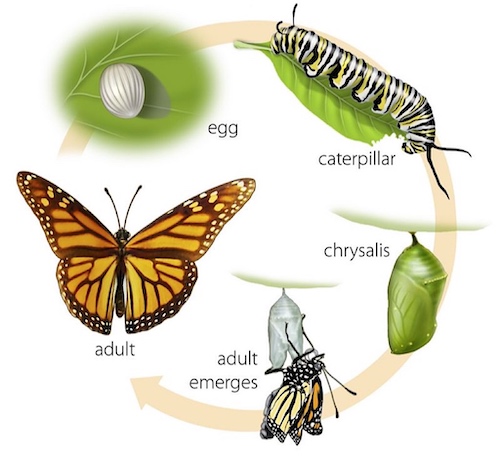
All butterflies have “complete metamorphosis.” To grow into an adult they go through 4 stages: egg, larva, pupa and adult. Each stage has a different goal – for instance, caterpillars need to eat a lot, and adults need to reproduce. Depending on the type of butterfly, the life cycle of a butterfly may take anywhere from one month to a whole year. The female attaches the egg to leaves, stems, or other objects, usually on or near the intended caterpillar food. When the egg hatches, the caterpillar will start work and eat the leaf they were born onto. This is really important because the mother butterfly needs to lay her eggs on the type of leaf the caterpillar will eat, each caterpillar type likes only certain types of leaves. As soon as a caterpillar is done growing and they have reached their full length/weight, they form themselves into a pupa, also known as a chrysalis. From the outside of the pupa, it looks as if the caterpillar may just be resting, but the inside is where all of the action is. Inside of the pupa, the caterpillar is changing rapidly into a butterfly, a momentous transformation. As soon as the butterfly has rested after coming out of the chrysalis, it will pump blood into the wings in order to get them working and flapping and the butterfly makes its first flight.
Butterfly Families

Identifying butterflies begins with learning the six butterfly families. The first five families—swallowtails, brush-foots, whites and sulphurs, gossamer-wings, and metalmarks—are called the true butterflies. The last group, the skippers, is sometimes considered separately. In order to show a greater diversity of butterflies and their families, I have included four sources. First is the Henderson Bird Viewing Preserve where I walk each morning. Next is the Springs Preserve, a botanical desert garden with an annual spring butterfly pavilion with gorgeous butterflies from all over. Finally butterflies from Costa Rica and Trinidad. There are more species in the Brush-Footed Butterflies (Nymphalidae) family than any other family. Brushfoots have a lot of variation. Sizes can vary from small to large. All adults have reduced front legs which can not be used for walking. They are commonly orange, yellow, brown, or black. Some adults can live 6–11 months, the most of any butterfly.
Monarch Butterfly
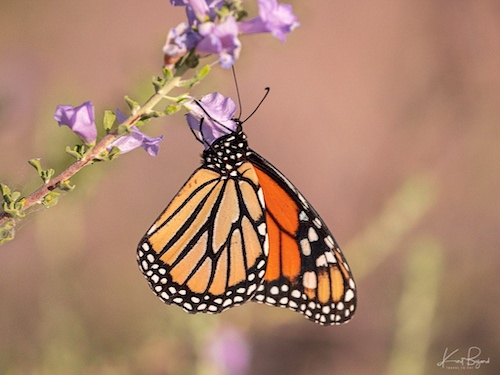
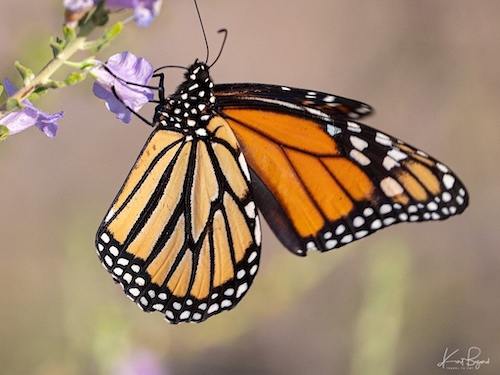
The Monarch Butterfly or simply Monarch (Danaus plexippus) is a milkweed butterfly in the family of Brush-Footed Butterflies (Nymphalidae). It may be the most familiar North American butterfly, and is considered an iconic pollinator species. Its wings feature an easily recognizable black, orange, and white pattern, with a wingspan of 3.5–4 inches (8.9–10.2 cm). In the Americas, the monarch ranges from southern Canada through northern South America. The range of the western and eastern populations expands and contracts depending upon the season. The range differs between breeding areas, migration routes, and winter roosts. Overwintering populations of D. plexippus plexippus are found in Mexico, California, along the Gulf Coast, year round in Florida, and in Arizona where the habitat has the specific conditions necessary for their survival.
Queen Butterfly
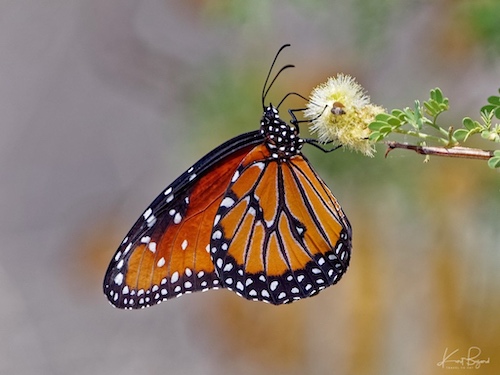
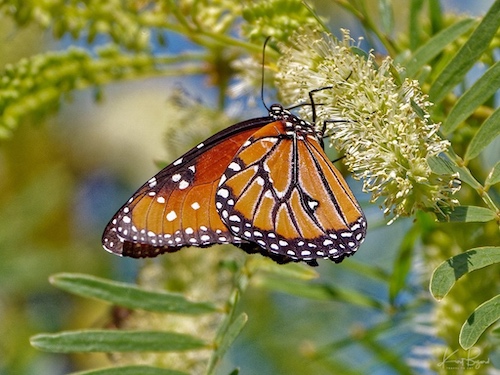
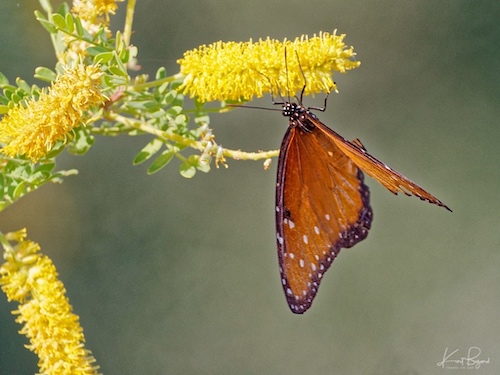
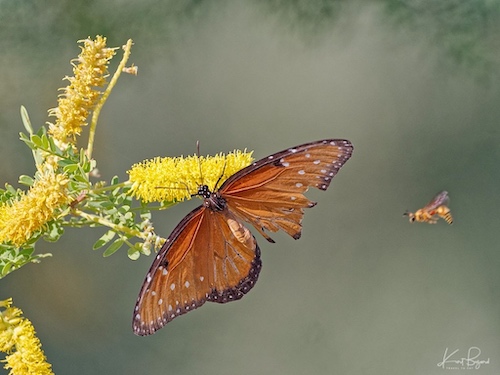
The Queen Butterfly (Danaus gilippus) is a North and South American butterfly in the family of Brush-Footed Butterflies (Nymphalidae) with a wingspan of 2.8–3.5 inches (7–8.8 cm). It is orange or brown with black wing borders and small white forewing spots on its dorsal wing surface, and reddish ventral wing surface fairly similar to the dorsal surface. A simple way to identify the Monarch from the similar looking Queen are the interior white spots on the upper/dorsal side of the wing. On the Monarch the spots are enclosed in black while the Queen has white spots surrounded by orange/brown. The Queen belongs to a family (Danaidae) that is common to both New and Old Worlds, specifically found throughout the tropics and into the temperate regions of the Americas, Asia, and Africa. Stray specimens are found in Europe. The Queen is chiefly a tropical species. In the US, it is usually confined to the southern portion of the country.
Gulf Fritillary
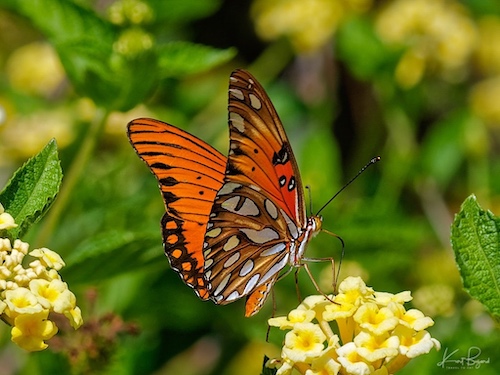

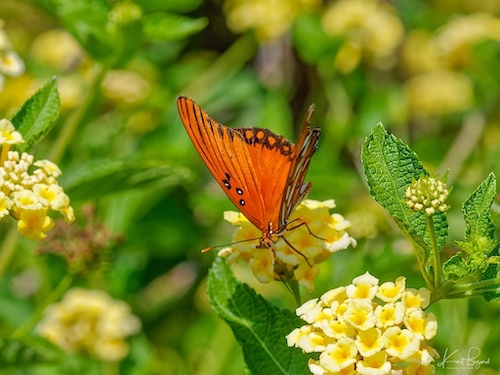
The Gulf Fritillary or Passion Butterfly (Agraulis vanillae) is a bright orange butterfly in the subfamily Heliconiinae of the family of Brush-Footed Butterflies (Nymphalidae). That subfamily was formerly set apart as a separate family, the Heliconiidae. The Heliconiinae are “longwing butterflies”, which have long, narrow wings compared to other butterflies. The gulf fritillary is a medium-sized butterfly that has extended forewings and a wingspan range of 2.5–3.7 inches (6.5–9.5 cm). This butterfly exhibits sexual dimorphism as females are typically distinctively larger in size than males. The underside of the wings is brown and speckled with silvery white dots. In contrast, the top surface layer of the wings is deep orange in color with black streaks running across. Gulf fritillaries are found primarily in the southern parts of the U.S., such as many regions of Texas and Florida. However, this butterfly’s range can extend from the southern U.S. into parts of Mexico and Central America and sometimes as far as parts of South America. They are also found in Hawaii.
Painted Lady
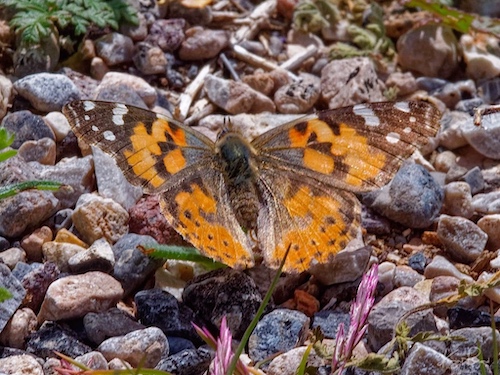

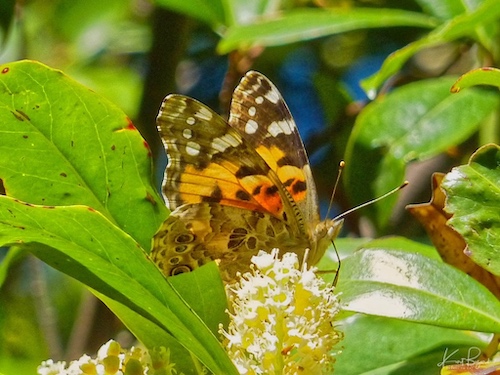
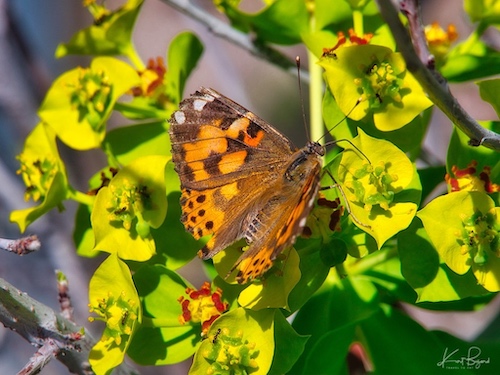
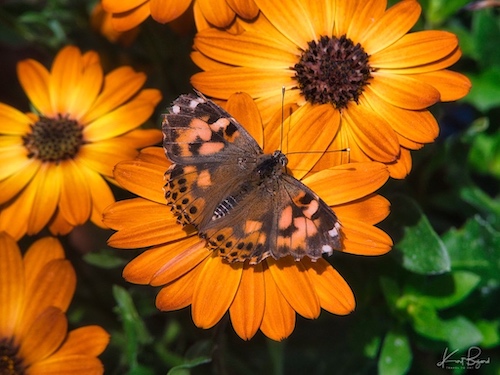

The Painted Lady (Vanessa cardui) is the most widely distributed butterfly in the world. It is found throughout Europe, Asia, Africa, North America, and Central America. It is not a permanent resident in the eastern United States, but quasi-periodically migrates there from the deserts of the southwestern U.S. and northern Mexico. Apparently the entire North American population winters near the US-Mexico border, breeding in the desert after the winter rains generate a crop of annual Malvaceous, Boraginaceous and Asteraceous hosts. The resulting butterflies migrate north, actually in much of the Northern Hemisphere. In good years (lots of desert rain) they may do so by billions, interfering with traffic and attracting the attention of the media. These migrations are sporadic and often enormous, as in 2019. The Painted Lady is in the family of Brush-Footed Butterflies (Nymphalidae), the largest family of butterflies. Adults are about 2–2.9 inches (5.1–7.3 cm) in length. There is a great deal of variation in size and color, desert-bred animals are classically small and pale, while ones from humid areas are large and richly-colored. The upper side of their wings are orange-brown. The front wings have a white bar on the leading edge, and the rear wings have a submarginal row of five tiny black dots. The underside of their wings have brown, black,and gray patterns with tiny spots.
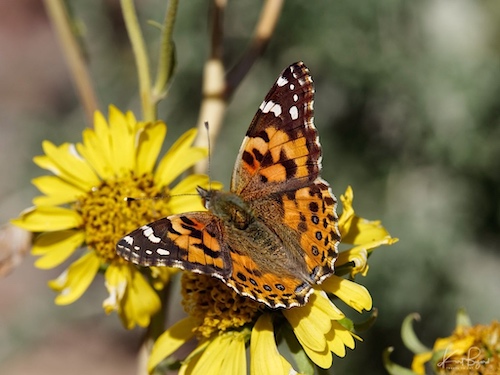
“The dorsal side of the wings is orange-patterned. On the underside of the hindwing are five small submarginal eyespots. Females are generally larger than males. The male forewing length ranges from 2.5 to 3.3 cm (mean = 3.0 cm) while the female forewing length ranges from 3.0 to 3.4 cm (mean = 3.2 cm) (Opler and Krizek, 1984). Vanessa cardui, has distinct summer and winter forms. The summer form is larger and brighter and has blue pupils in the submarginal spots on the dorsal hind wing (Opler and Krizek, 1984). The winter form has entirely black wing spots.” Obviously, the Painted Lady seen above that I photographed in February of this year did not get the memo about blue pupils in the submarginal spots.
Painted Lady vs West Coast Lady
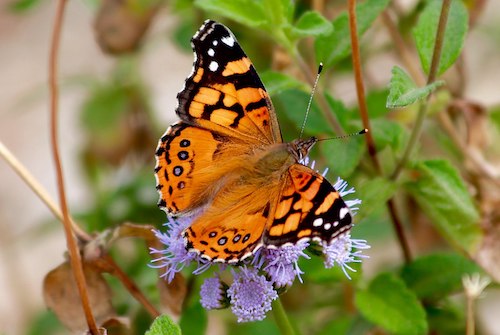
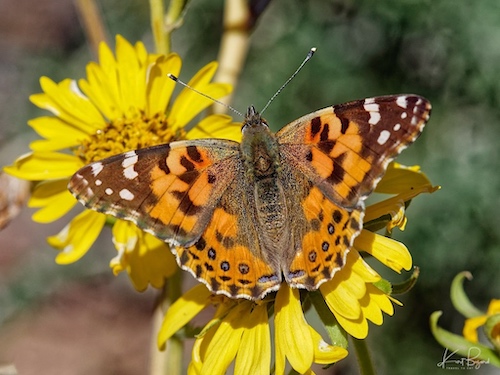
When I took the above photograph of the Painted Lady (second photo down), I misidentified it as a West Coast Lady based on the blue spots surrounded by black on the rear wing margins. Since then, I have learned the error of my ways. The West Coast lady (Vanessa annabella) is one of three North American species of brush-footed butterflies known colloquially as the “painted ladies” in the family of Brush-Footed Butterflies (Nymphalidae). Vanessa annabella occurs throughout much of the western US and southwestern Canada. The other two species are the Painted Lady (Vanessa cardui) and the eastern American Painted Lady (Vanessa virginiensis), all look at least similar. Seen from above, the wings are a vivid orange, with a brown and white pattern. The West Coast Ladies sometimes fly around with the Painted Lady, but their numbers are much lower in comparison.
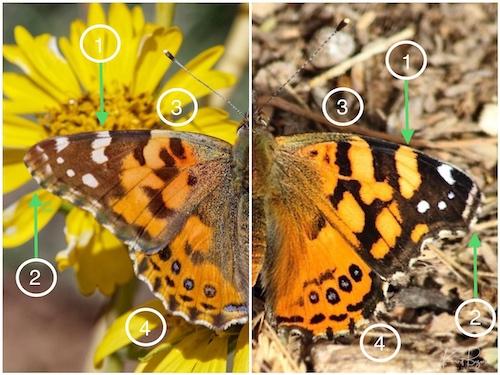
The dorsal (upper) side of the wings of the West Coast Lady (Vanessa annabella) are similar to the Painted Lady (Vanessa cardui), with four distinguishing differences: (1) upper surface of forewing with orange (not white) postmedian bar, (2) forewing apex squared off (clipped), (3) black bar completely crossing forewing cell, (4) uppersurface of hindwing with 3–4 submarginal blue spots sharply ringed in black.
Red Admiral
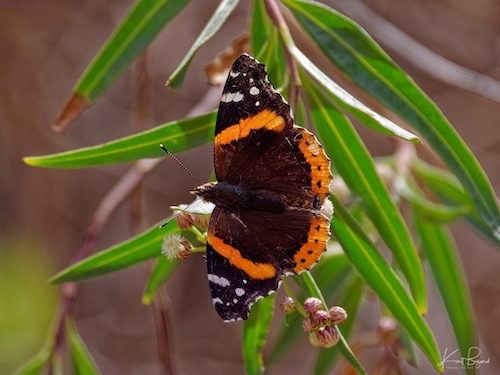
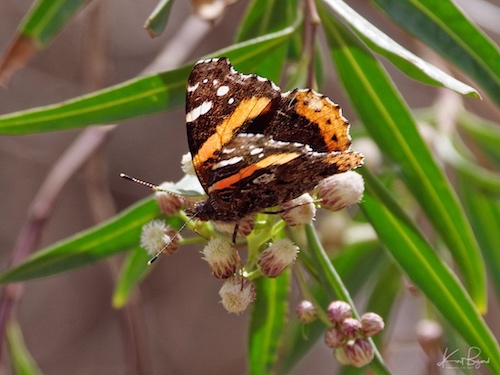
The Red Admiral (Vanessa atalanta) is a medium-sized butterfly with black wings, red bands, and white spots in the family of Brush-Footed Butterflies (Nymphalidae). It has a wingspan of about 2 inches (5 cm). The forewing of this butterfly bears on a black ground an oblique vermilion band and a group of white subapical spots. On the hindwing the larger portion of the distal margin is red, with a row of small black spots and at the anal angle an elongate blue spot. The red admiral is found in temperate regions of North Africa, North and Central America, Europe, Asia, and island regions of Hawaii, New Zealand, and the Caribbean.
Western White

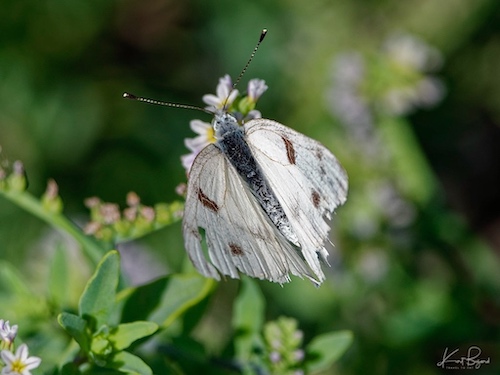
Pontia occidentalis, the western white, is a butterfly in the family of Whites and Sulphurs (Pieridae). This is a small and common butterfly with a wingspan of 1.4–2 inches (3.8–5.3 cm). It is very similar to and difficult to separate from the Checkered White, which it largely replaces at higher elevations. The host plants are from the mustard or cabbage family, Brassicaceae. The caterpillars eat especially the flowers, buds and fruit. In the north of the range, one generation flies in June and July; in the south two generations fly from May to August. It is found in Western North America, Alaska south to California, northern Arizona and northern New Mexico; east to North Dakota and central Ontario.
Yuma Skipper


The Yuma skipper (Ochlodes yuma) is a species of grass skipper in the family of Skippers (Hesperiidae). This is a small butterfly with a wing span of 1.1–1.4 inches (2.9 – 3.5 cm). The upperside has narrow dark borders blending into the reddish orange ground color, dark veins, and small indistinct pale spots. It is common in its limited habitat in California, Nevada, Utah, Colorado, northern New Mexico, and Arizona.
Spicebush Swallowtail
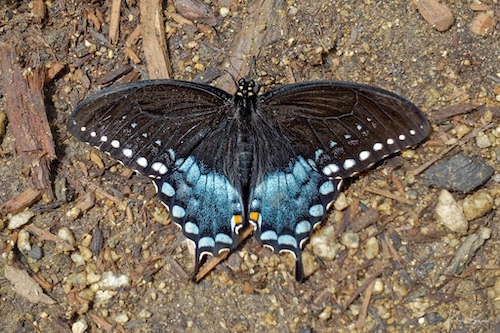
The Spicebush Swallowtail (Papilio troilus) is a common black swallowtail butterfly found in North America which derives its name from its most common host plant, the spicebush, members of the genus Lindera. The family to which spicebush swallowtails belong, Swallowtails (Papilionidae), include the largest butterflies in the world. The swallowtails are unique in that even while feeding, they continue to flutter their wings. Unlike other swallowtail butterflies, spicebushes fly low to the ground instead of at great heights. The wingspan of a spicebush swallowtail ranges from 3–4 inches (7.6–10.2 cm). Adults are primarily black/brown in color, with a trademark green-blue (male) or bright blue (female) splotch in the shape of a half moon on the hindwings. The range is confined to the Southeastern coastal United States, namely throughout Florida and along coastal Georgia and in places in Texas.
Pipevine Swallowtail
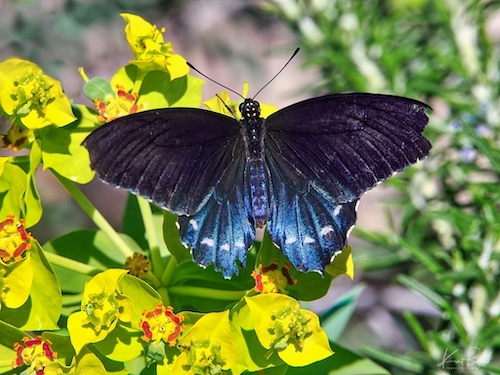


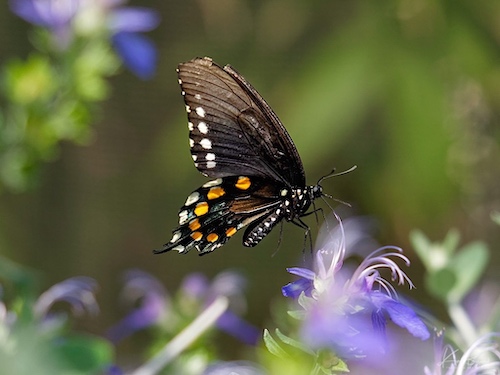
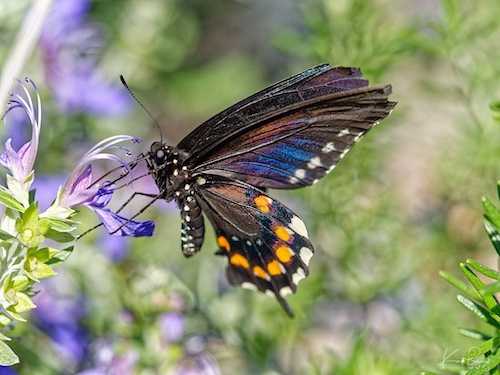
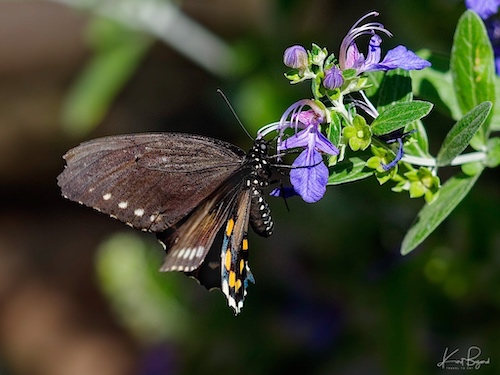
The Pipevine Swallowtail (Battus philenor) is a large swallowtail butterfly found in North America and Central America, obviously in the family of Swallowtails (Papilionidae). They have a wingspan from 2.75–1.2 inches (7–13 cm). On the dorsal/top wing is black, with a strong blue-green iridescence, more pronounced in the male, and a row of white, submarginal spots on both wings. On the ventral/underside are a very distinct submarginal row of orange spots, ringed with black, on an iridescent blue-green background. They are found in many different habitats, but are most commonly found in forests. It has a wide distribution across the Northern Americas. In the United States, the butterfly is found in New England down to Florida west to Nebraska, Texas, New Mexico, Arizona, California, and Oregon.
Polydamas Swallowtail
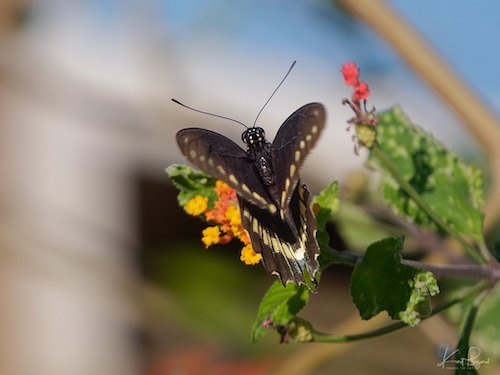
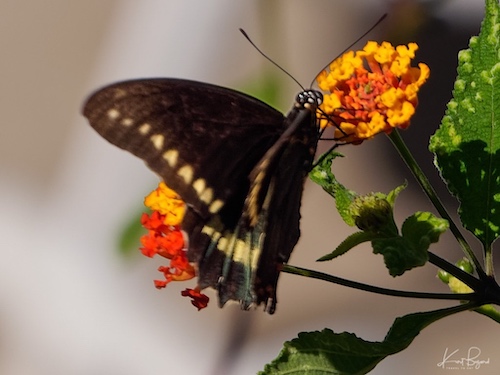
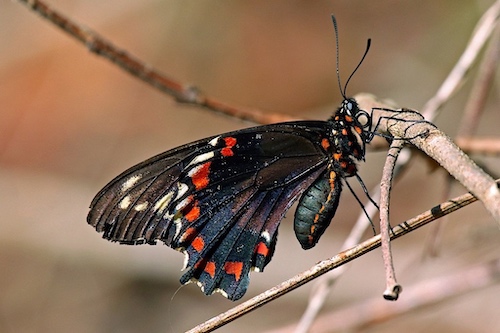
Battus polydamas, also known as the gold rim swallowtail, the Polydamas swallowtail or the tailless swallowtail, is a species of butterfly in the family of Swallowtails (Papilionidae). The wingspan is 3.5–4.7 inches (9–12 cm) without the tail. The top of the wings are black with a broad submarginal band formed by large yellow spots. The undersides of the forewings have the same pattern, while the hindwings have a submarginal row of red lunules. This butterfly flies from April to November in three generations in the north of its range, throughout the year in several generations in the tropics. The larvae feed on Aristolochia plant species.
Cattleheart Butterfly


The Anchises Cattleheart Butterfly (Parides anchises) is a species of butterfly in the family of Swallowtails (Papilionidae) native to the Americas. The wingspan is about 9 – 10 cm. The basic color of this butterfly is dark-brown or black. Red and green areas dominate the wings. The hind wings have no tails. The range is almost entirely in South America. There are 20 subspecies, the one for Trinidad is Parides anchises cymochles.
White Peacock
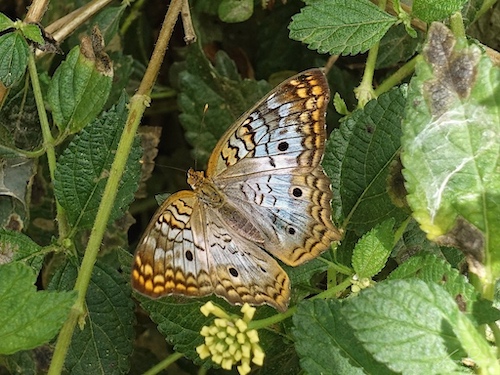
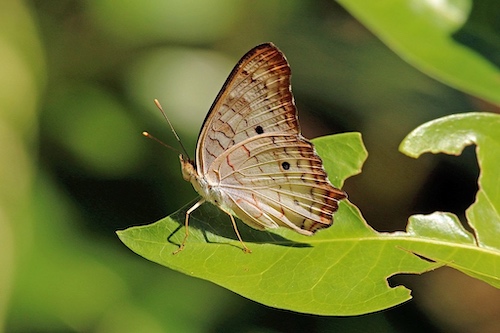
The White Peacock (Anartia jatrophae) is a species of mostly-white butterfly, seen in parts of both the Americas, in the family of Brush-Footed Butterflies (Nymphalidae). The wingspan is 2–2.5 inches (5.1–6.4 cm). The upperside is iridescent white with light brown markings and a double row of light crescents at the margins. The forewing has one round, black spot; hindwing has two. It Is resident from Argentina north through Central America, Mexico, and the West Indies to South Texas and southern Florida. It migrates and temporarily colonizes to central Texas and coastal South Carolina.
Peleides Blue Morpho
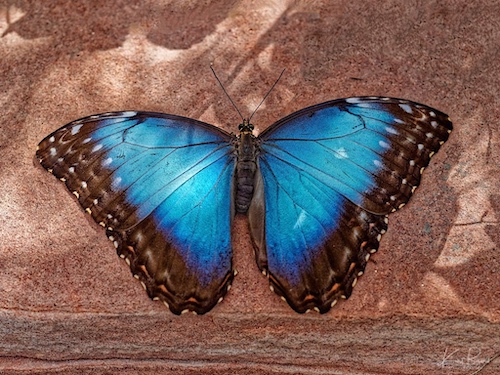

The Peleides Blue Morpho (Morpho peleides) is one of the most widespread and abundant Morpho species, occurring from Mexico through Central America, and in South America down to Paraguay. They are large butterflies, with adult wingspan measuring 5–8 inches (12.7–20.3 cm) in the family of Brush-Footed Butterflies (Nymphalidae). It occurs in large populations in montane and lowland forests, typically in areas of secondary plant growth. It is recognized by the iridescent blue coloration on the dorsal (top) side of the wings. The undersides of the morpho’s wings are a dull brown color with many eyespots, providing camouflage against predators such as birds and insects when its wings are closed. The morpho butterflies comprise many species of Neotropical butterflies under the genus Morpho. This genus includes over 29 accepted species and 147 accepted subspecies, found mostly in South America, Mexico, and Central America.
Julia Butterfly

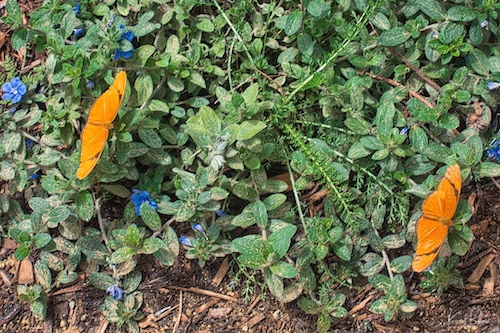

The Julia Butterfly (Dryas iulia), often incorrectly spelled julia, is a butterfly in the family of Brush-Footed Butterflies (Nymphalidae). Its wingspan ranges from (82–92 mm), and it is colored orange (brighter in male specimens) with black markings; this species is somewhat unpalatable to birds and belongs to the “orange” Mullerian mimicry complex. It is the sole representative of its genus Dryas, it is native from Brazil to southern Texas and Florida, and in summer can sometimes be found as far north as eastern Nebraska. Over 15 subspecies have been described. Heliconiini is a tribe of butterflies in the subfamily Heliconiinae, also known as the passion-vine butterflies. This group has roughly 100 species and subspecies distributed primarily in the Neotropics.
Postmen Butterflies
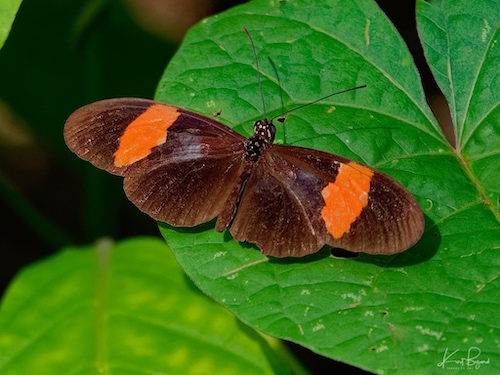
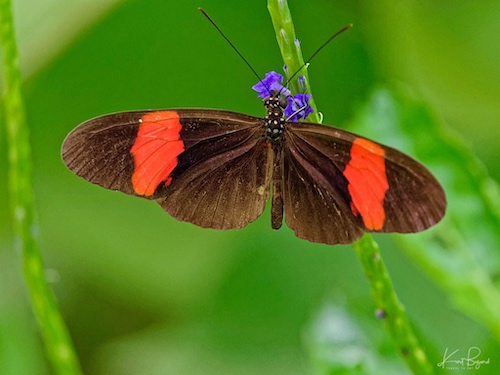

“Known as postmen in Trinidad & Tobago, Heliconius erato (Linnaeus) and Heliconius melpomene (Linnaeus) are widely distributed in Central and South America. Both species are common and widespread in open habitats in Trinidad and Tobago, H. erato being usually the more common. The Trinidad forms have been named H. erato adana by J.R.G. Turner, 1967 and H. melpomene flagrans by Stichel, 1919 (Cock 2014), while the Tobago forms which are similar but smaller and with narrower red bands on the forewing have been named H. erato tobagoensis by Barcant, 1982 and H. melpomene tessa by Barcant, 1982. Although both species are extremely variable across their range on the mainland, in any given locality the colour and markings are constant, and the two species closely resemble each other. Thus, in Trinidad and Tobago, both species are black with a broad red band across the dorsal forewing, which is paler on the ventral hindwing. The most reliable way to separate the two species is based on the number of small red spots at the base of the ventral hindwing: three in H. melpomene and four in H. erato, the extra one in H. erato being at the base of the cell. However, in the field, and especially in photographs, often only the top (dorsal) surface is visible, making identification difficult.” Cock, M.J.W. 2020. Nature Note – Field identification of the postmen Heliconius erato and H. melpomene (Lepidoptera, Nymphalidae, Heliconiinae), in Trinidad &Tobago Living World, Journal of the Trinidad and Tobago Field Naturalists’ Club.

There are often striking differences between the different forms of each species of the Postman butterfly as seen above.
Banded Peacock Butterfly
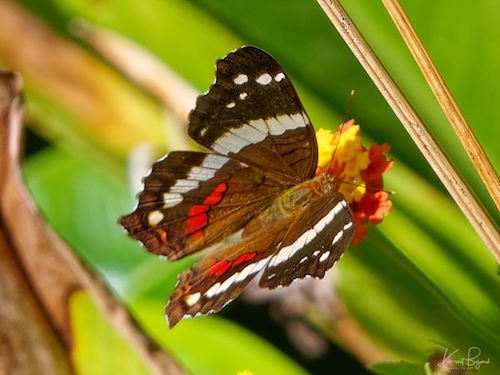
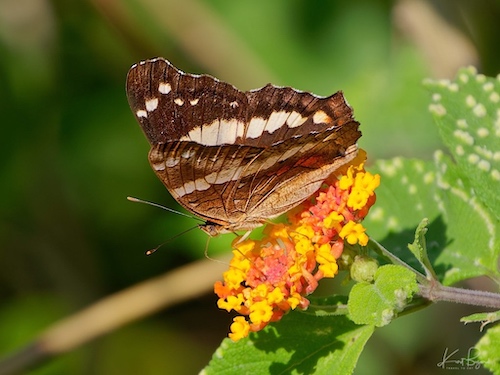
The Banded Peacock Butterfly (Anartia fatima) is a butterfly in the family of Brush-Footed Butterflies (Nymphalidae). It is commonly found in south Texas, Mexico, and Central America but mostly studied in Costa Rica. This butterfly prefers subtropical climates and areas in which there is a lot of moisture, such as near rivers. The wing span is 2.4–2.6 inches (6–7 cm). This species has two polymorphic forms, one which is white-banded and another that is yellow-banded. Both of these morphs have a median band running across both the forewing and hindwing, a red band in the hindwing and seven small spots near the apex and post median area of the forewing. There is no distinction between males and females. Its range generally begins in southern Texas and continues south through Mexico and all of Central America and Panama. It is quite ubiquitous throughout its range. After this point, Anartia fatima is no longer found and a closely related species, Anartia amathea, becomes prevalent.
Scarlet Peacock Butterfly


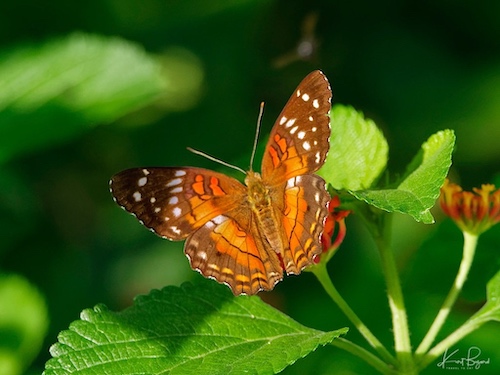
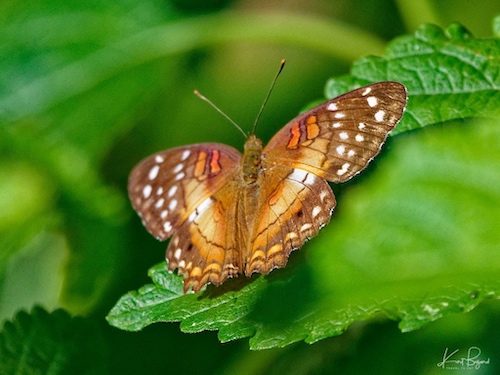
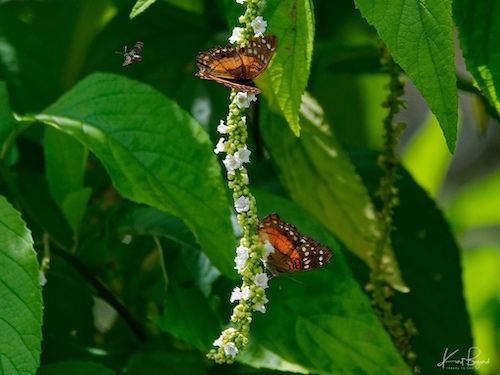
The Scarlet Peacock Butterfly (Anartia amathea) is a species of the family of Brush-Footed Butterflies (Nymphalidae), found primarily in South America. The wing span is 2.4–2.6 inches (6–7 cm). This butterfly is very similar to the Banded Peacock (Anartia fatima), seen above, which primarily exists north of the range of Anartia amathea. The type locality is probably Suriname, and the species is found from Panama to Argentina; Grenada, Barbados and Antigua. It consumes nectar. It is reported as common in Argentina, Paraguay, Uruguay, the Brazilian highlands, the eastern Amazon, the Guianas, Venezuela, and Panama, as well as Trinidad and other Caribbean islands. There are 5 Anartia species of which jatrophae and amathea are the most widespread. The others are lyrtea from Haiti, chrysopelea from Cuba, and fatima from central America.
Orion Cecropian
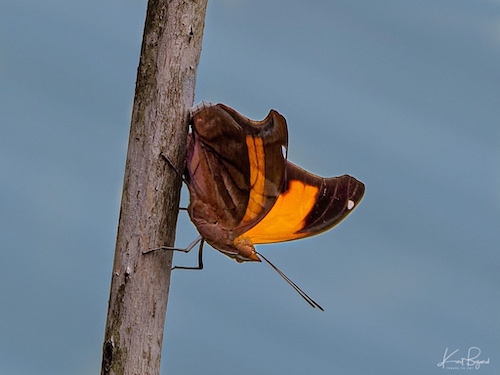
The Orion Cecropian or Stinky Leafwing (Historis odius) is in the family of Brush-Footed Butterflies (Nymphalidae). It has a wingspan of 4 inches (11 cm) and calls attention with its bright orange upperparts when flying. However, at rest, they fold their wings up, revealing their leaf-like brown underside, even showing a vertical line reminiscent of the vein of a leaf, providing excellent camouflage. They are very closely associated with cecropid trees-from laying their eggs on the leaves, to perching high on its brdnches, all life stages of this species are associated with cecropid trees. From the treetops, it flies down to the ground to feed on fermenting forest fruits, earning this species its nickname, the “Stinky Leofwing.” Common to the West Indies, Trinidad, South & Central America, the Orion Cecropian prefers forested habitats such as the deciduous woodlands of Costa Rica, the rainforests of the Amazonian jungle, and the cloud forests near the base of the Andes Mountains. There are three subspecies.
Hewitson’s Metalmark

Hewitson’s Metalmark (Nymphidium onaeum) is a species of butterfly in the family of Metalmarks (Riodinidae). The range is Panama to southern Mexico. There is virtually nothing written about this beautiful butterfly but I did manage to find a related species from Trinidad (Nymphidium trinidadi). Apparently, these two butterflies have been confused with one another in the past. Nymphidium trinidadi ranges from the island of Trinidad across northern Venezuela to Colombia.
Emesis fatimella
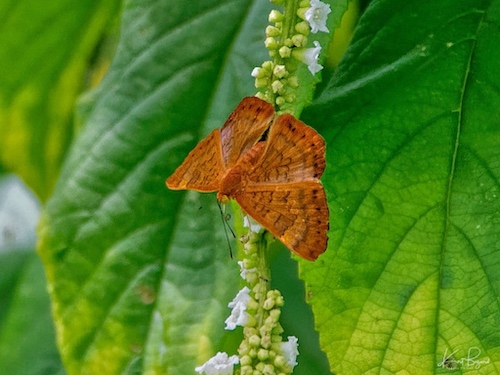
Emesis fatimella is a small butterfly in the family of Metalmarks (Riodinidae). The wingspan is 1–1.25 inches (2.5–3.2 cm). The distinctive wing pattern and shape of Emesis make them instantly recognisable as a genus, but some of the 41 species can be difficult to tell apart, requiring close examination of the markings. The upperside is brown with faint markings with a line of dark spots along the margin of both forewing and hindwing. Emesis fatimella is found from Mexico to Brazil and Peru and obviously Trinidad and Venezuela. David Ahrenholz points out that there are darker forms and lighter ones.
Great Southern White
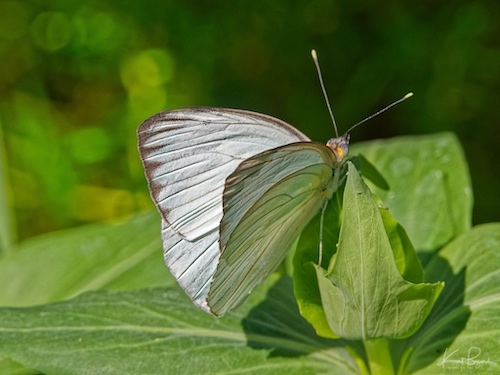

The Great Southern White butterfly is found in the southern part of eastern and central US, primarily in coastal states. It is found from the Atlantic and Gulf coasts of the United States, and south through tropical America to Argentina. It is migratory along the southeastern coast of the United States, with strays to Maryland, Kansas, and Colorado. It is a very common butterfly along roadsides and fields. They stay near the coasts, flying year-round in southern Florida and during the warmer months in the central and northern peninsula. Males are the whitest while females range from slightly off-white to almost pure charcoal. The tips of their antennae are baby blue. Females lay eggs on plants in the mustard family. Their primary hosts in southern Florida seem to be Virginia Peppergrass and Wild Radish.
Lyside Sulpher
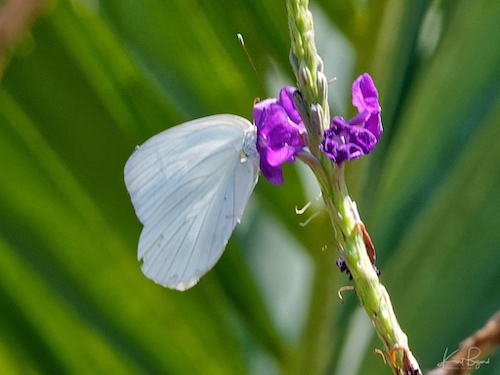
Kricogonia lyside, the lyside sulphur or guayacan sulphur, is a North American, Caribbean, and South American butterfly in the family of Whites and Sulphurs (Pieridae). It has a wingspan of 1.5–2.4 inches (3.8–6 cm). The upperside of the wings is pale yellow, usually with a black bar on the leading edge of the hindwing and a bright yellow patch near the base of the forewing. The underside of the wings varies from a greenish color to bright yellow to almost white. The underside of the wings varies from a greenish color to bright yellow to almost white. Similar species in the lyside sulphur’s range include Queen Alexandra’s sulphur (Colias alexandra), the cloudless sulphur (Phoebis sennae), and the statira sulphur (Aphrissa statira). The range is Venezuela north to southern Texas, where it occurs in great numbers. Rare in southern Florida; strays to Colorado, Nebraska, Kentucky, and other states.
Orange-Barred Sulphur
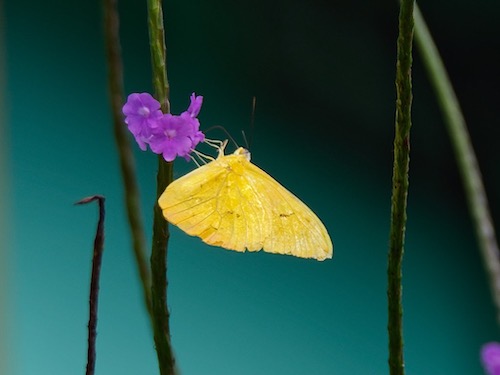

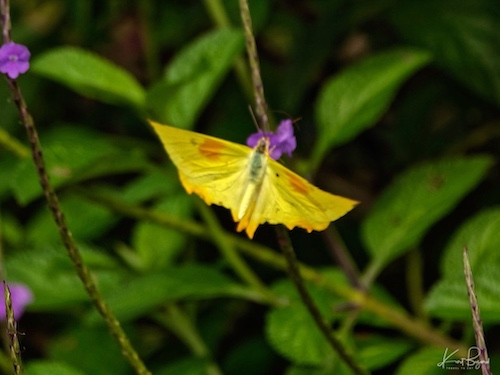
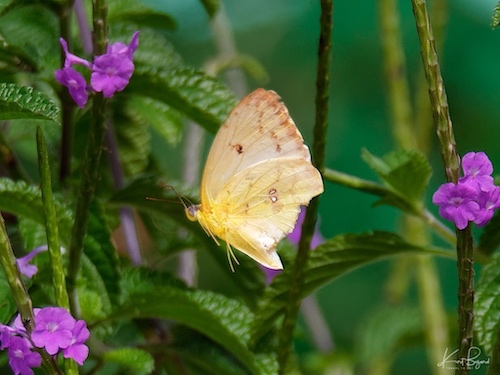
The Orange-Barred Sulphur (Phoebis philea)is a species of butterfly found in the Americas including the Caribbean in the family of Whites and Sulphurs (Pieridae). The wingspan is 2.7–3.1 inches (6.8–8 mm). There are two to three generations per year in Florida and one in the northern part of the range with adults on wing from mid to late summer. The species habitat is in tropical scrub, gardens, fields, and forest edges.

Orange-barred sulphurs are often found in large dense groups of mixed species, including the Statira Sulphur (Aphrissa statira), Apricot Sulphur (Phoebis argante), and the Straight-Line Sulphur (Rhabdodryas trite). The species eats nectar from red-colored plants.
Butterfly Fossils

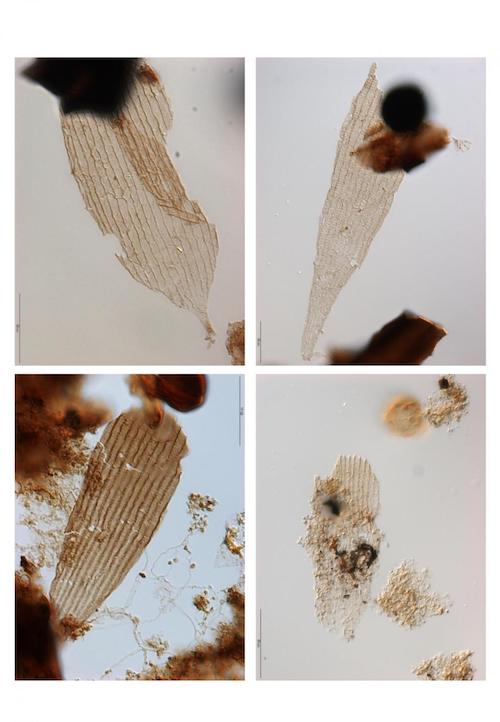
In 2018 a remarkable study was published by Utrecht University researchers Timo van Eldijk and Bas van de Schootbrugge with Boston College Research Professor Paul K. Strother, reporting the oldest fossilized remains of insects from the order Lepidoptera (moths and butterflies) known to date. The fossils, mostly wing scales, were more than 70 million years older than the oldest fossils of flowering plants, and they cast a new light on the so-far presumed co-evolution between flowering plants and pollinating insects. Visiting a colleague in Germany in 2012, Boston College Research Professor Paul K. Strother was examining soil samples for pollen, spores, pieces of plants and insect legs — organic debris that might otherwise have been considered “pond scum” when it was trapped in sediment during cataclysmic earth events 200 million years ago. They used acid to dissolve these ancient rocks, leaving behind small fragments, including “perfectly preserved” scales that covered the wings of early moths and butterflies. In the years since, Strother and his colleagues amassed additional evidence that moths and butterflies emerged at least 200 million years ago. These early insects belonged to a suborder named Glossata. The findings cast new light on the classic example of co-evolution: the evolutionary interplay between pollenating insects — flies, bees, wasps, butterflies and moths — and angiosperms, or flowers. “Our discovery did not change this, but instead, it demonstrated that the Glossata, which gave rise to the Lepidoptera (moths and butterflies), evolved earlier by a feeding adaptation to the gymnospermous ovules, or the pollen droplets,” said Strother. “These insects later transferred their feeding preference onto angiosperms, and as a result, ended up co-evolving with flowers where they function to transfer pollen as they feed on nectar.” The early record of wing scales with unequivocal glossatan characteristics implies that not only adult moths but also their larval stages could have depended on gymnosperms to satisfy their nutritional needs. The transition to exclusively feeding on liquids was most likely an evolutionary response to widespread heat and aridity during the Norian in the late Triassic period (208–227 Mya). Whatever the trigger for the development of the butterfly proboscis, it was clearly an evolutionary innovation that resulted in phenomenal diversity and added immensely to the beauty of planet Earth.
Conclusion

As always I hope that you enjoyed the post and will come back for more in the future. I have given up apologizing for the length of my posts, I end this one with Antonio Canova‘s masterpiece of Psyche and Cupid from the Louvre, almost as beautiful as the butterflies themselves.
References
Henderson Bird Viewing Preserve. eat.webtoseo.com
Trinidad and Tobago Bees, Butterflies and Bugs
Hummingbirds, Butterflies and Flowers of Costa Rica
Phylogenomics reveals the evolutionary timing and pattern of butterflies and moths
A Comprehensive and Dated Phylogenomic Analysis of Butterflies
Butterfly Anatomy and Terminology. Northwest Butterflies by Caitlin LaBar
Springs Preserve Butterfly List
Painted Lady Migrates Through Southern California
New taxa of Neotropical Riodinidae (Lepidoptera). Curtis J. Callaghan
Wing patterning gene redefines the mimetic history of Heliconius butterflies. Heather M. Hines et al
Butterflies Steer with a Magnetic Compass
A Triassic-Jurassic window into the evolution of Lepidoptera
We can soon thank butterfly tongues for better cancer treatments and vaccines

